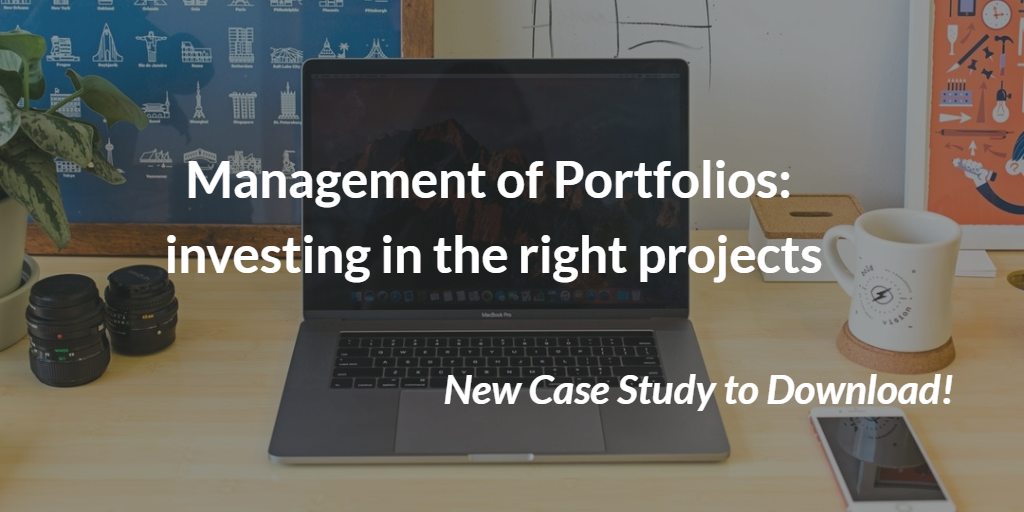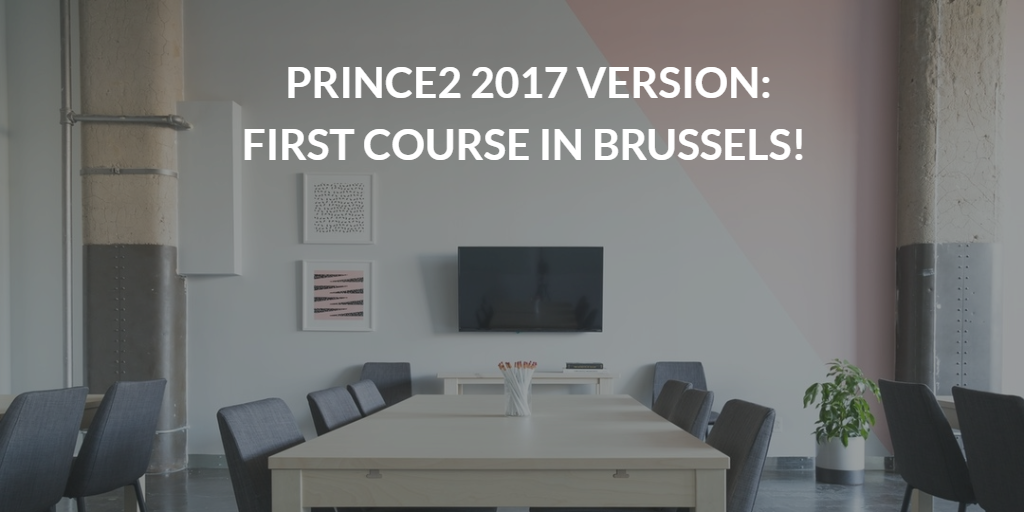News
View the latest inspiring and positive news and information about what's going on in the PM and IT world.

A portfolio management approach to business change is required to ensure that organizations prioritize and invest in the changes that contribute most to the strategy. It provides an overview of all change activities including what is in the portfolio, what it is costing, what risks are faced, what progress is being made, and what the impact is on business as usual and the organization’s strategic objectives. Not only Business as Usual prioritization, Management of Portfolio means to effectively decide to invest in the change initiatives that will contribute to deliver strategic objectives.
TITLE: 100 Days to Implement Management of Portfolios
ABOUT THE ARTICLE: "At the Office for National Statistics (ONS) we collect, analyse and publish important statistics such as population, inflation and gross domestic product. This information is used to inform decisions that affect your life and the lives of everyone in the UK. We were aware that some studies indicated a timescale of 12–18 months to implement portfolio management. However, we decided to embark on a 100-day, high-energy approach to implementing the Cabinet Office’s best-practice standard Management of Portfolios (MoP). During the implementation we derived considerable value from enhanced executive portfolio-level information, portfolio prioritization, consistent portfolio investment appraisals and project sequencing. All of this led to a greater understanding of the portfolio delivery landscape and the ability to make more confident investment decisions with an overall increase in collaborative working and organizational energy". This is how Glen Watson, General Director of the Office for National Statistics explains the decision of implementing MoP.
This Case Study follows the steps of the Portfolio implementation highlighting the key phases of this 100 days project: in the terms of the ONS, the path was to "understand where we are" to define "where we want to go": this includes the analysis of the current situation, the definition of the so called "portfolio cycle", "portfolio plan" and "portfolio office". To summarize, at the end of the paper are indicated 8 top tips (in no particular order) which are the things ONS found critically important when implementing portfolio management within 100 days.
ABOUT THE AUTHOR: Craig Kilford worked with the Office for National Statistics as Interim Deputy Director of Portfolio Management. As one of the world’s leading portfolio management subject matter experts he is a regular motivational conference speaker, co-author of the Cabinet Office’s Management of Portfolios and author of "Think P3O." Craig blogs regularly at www.MrPortfolioManagement.com where additional information about this case study is available.
TO READ AND DOWNLOAD THE FULL ARTICLE: simply follow this link!

- the strategic direction of the organization,
- the delivery of change capability by projects,
- the need to maintain business performance and stability while realizing and exploiting the benefits from the investments.
- Vision-led programmes that start with a clearly defined vision, have a top-down approach, and focus on strategic or innovative opportunity with radical transformation of business, culture or both.
- Emergent programmes evolve from current uncoordinated initiatives, where there is recognition of the value of a joinedup approach with an emergent vision and end goal.
- Compliance programmes can also be called ‘must do’ programmes. The organization has no choice but to change; for example, because of market forces or the potential negative impact of not changing.

Today’s project management pressures
Project managers (and the projects they’re responsible for) are not immune to the effects of a changing global economy. In fact, the majority of project managers acknowledge that there is increased business competition which is causing a variety of knock-on effects. Some findings:- 76% states that “The business environment has become more competitive”
- 74% states that “Budgets and timelines are tighter as clients/ stakeholders look for more value from projects”
- 65% states that “PMs are expected to deliver more projects over a shorter time frame”
Project management maturity within organizations
The maturity of project management in many organizations is still behind where it needs to be to meet the increased demands of more projects within existing timeframes and budgets. One measure of maturity can come from the P3M3 Maturity Model, yet:- less than 20% of organizations described themselves as having established processes in place, with ongoing improvements based on monitoring and feedback
- only 53% of project managers describe the project management function as “influential”
The challenges faced by project managers today
At the head of the list of the challenges faced by PMs today there is “over-ambitious timeframes” for projects, followed closely by “changing project briefs and moving expectations”. In the context of increasing project numbers to deliver in the same timeframe or less, plus the relative isolation of the PMO in organizations, these are serious challenges for project managers. Following in the list there are also challenges like “poor communication”, “absence of the right people for the job”, “unrealistic budgets” and “inefficient work practices”.- Half of project managers felt their project didn’t have the right people in place, which led to project failure in 43% of cases
- 56% of project managers had witnessed significant changes to the project brief and expectations and this led to project failure in 48% of cases
Agile
Agile continues to be a hot topic within project management. There is a huge appetite amongst project managers for agile techniques, yet this enthusiasm isn’t apparent at an organizational level. Why are so many organizations wary about adopting agile? It could be due to a lack of understanding as ‘agile’ is still perceived as the latest buzzword. Project managers need to educate the business about the value of agile to help deliver the number of projects that organizations are now demanding. Organizations need to get on board with adopting agile techniques. Working in an agile way allows project managers to respond to evolving business needs but still the appetite for adoption at an organizational level is low.- 77% of respondents seeing value in working in a more agile way and just 2% seeing no value in it
- Less than half (46%) of respondents said there is significant appetite for adopting agile techniques within their function and this falls further to 39% at an organizational level
Learning and development
This research has identified a lot of challenges facing project managers, but there were also some positive findings too, especially around ongoing development. Continuing professional development (CPD) is an activity that is commonly associated across professions such as accountancy, medicine and law. However, the majority of project managers recognize its importance and are actively participating in CPD. The only thing that could hold them back is a lack of investment from organizations. If you delve deeper both individuals and organizations are on the same page. Individuals want to do their job more effectively and organizations want to improve the effectiveness of their teams.

If you don't plan it, you won't do it. Planning is very important in Project Management, and it is considered one of the most important skills of a great Project Manager; in one of the articles of our library, Planning is listed among the 5 MUST for every PM, beginners and experienced ones.
Then why you shouldn't be planning that important training you want to get done in 2018? Why you shouldn't be working on a plan for the certification that will prove your skills as Project Manager?
Agenda's can become very busy during the year, and planning that training that you've always wanted to take can be difficult at times: at QRP International we know it, that's why we've decided to help you schedule your next training with a great incentive: a 20% Early Bird discount on ALL PRINCE2 courses!
Keep reading to know how it works!
EARLY BIRD PROMOTION: HOW DOES IT WORK?
QRP International has decided to meet the needs of its customers by adding a special promotion for the full PRINCE2 Training Calendar: on all PRINCE2 Foundation and Combi (Foundation & Practitioner) courses of 2018, you can benefit from a very special Early Bird promotion (20% OFF!).
BOOK IN ADVANCE AND SAVE MONEY! Sign up for the best deals by making your reservation early (at least 30 days before the start date of the training) in order to benefit from the special 20% Early Bird discount!
To check out the full calendar of training available with the Early Bird option, visit the following pages:
- PRINCE2 Foundation: full calendar of courses in Early Bird Promotion
- PRINCE2 Combi (Foundation & Practitioner): full calendar of courses in Early Bird Promotion

The 2017 updated version of PRINCE2 has been developed closely with the PRINCE2 community worldwide and taking into considerations several drivers for change. One of the most urgent one is the increased professionalism within the PM community: project management will be more and more considered a wide business skill and this will, as a consequence, require a continuous improvement from every PM working in the field.
The only language ready with the 2017 version is ENGLISH: French, Spanish, Italian and Dutch will be translated starting from January 2018.
QRP International is scheduling the first PRINCE2 courses with the 2017 version, to make sure to provide the most up-to-date Project Management content to its customers: the first "PRINCE2 2017 Version" training will take place in August, and it's already CONFIRMED!
PRINCE2 Foundation + Practitioner training: 21-22-23-24-25 August 2017 => Follow this link to know more on the training and to hold your seat! If you register within the 21st of July, you will benefit from a 20% EARLY BIRD DISCOUNT!
WHAT'S NEW IN 2017 VERSION? METHOD CHANGES
The 2017 update of PRINCE2 builds on the proven strength of PRINCE2 while responding to current imperatives for flexibility and agility. You will discover how the core of the PRINCE2 method, like principles, processes and themes remain unchanged, while a renewed focus on the importance of tailoring has been added: the chapter on tailoring has been, in fact, elaborated and more prominently placed at the beginning of the manual, and it contains clear indications about:
- what you can and cannot tailor
- who is responsible for tailoring and documenting
- examples of different project environments
- tailoring and embedding PRINCE2 in an organization
Furthermore, the distinction between tailoring, adopting and embedding is explained in more detail and there is guidance on how to adopt and embed PRINCE2 in an organization.
WHAT'S NEW IN 2017 VERSION? EXAM CHANGES
- FOUNDATION EXAM --> The Foundation was previously of 75 questions, and it has now changed into 60 questions. The duration is still 1 hour, while the pass mark goes from 50% (35/70), to 60% (36/60). Also the style of the questions have changed, since almost all negative questions have been removed and the number of list and missing word questions have been reduced.
- PRACTITIONER EXAM --> The Practitioner exam was previously of 80 questions, and it has changed into 75 questions. Duration and pass marks remain unchanged. Question styles retained are classic multiple choice and matching (2 columns), while multiple response (2 correct answers out of 5 possible answers) and assertion reason (True/false questions) have been removed. While previously the Practitioner exam only addressed 6 themes and 2 process with the NEW version all themes, all processes and the principles will be tasted. Last important change concerns the validity of the Practitioner certification: from the launch of the new exams the NEW Practitioner validity will be of 3 years ( not 5 years). To know more on the CERTIFICATION changes you can read this simple and informative article.
TO KNOW MORE ABOUT PRINCE2 2017 UPDATE
- WHAT’S THE FUTURE FOR PMs? – Read more
- WHAT CHANGES IN THE METHOD? – Read More
- WHAT CHANGES IN THE CERTIFICATION? - Read More
MORE THAN ONE COLLEAGUE FOR THE SAME COURSE?
Get in touch to get a personalized quotation, or get in touch to know more about KMO portefeuille.






